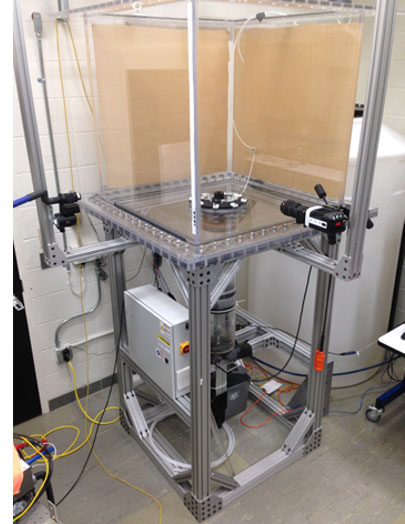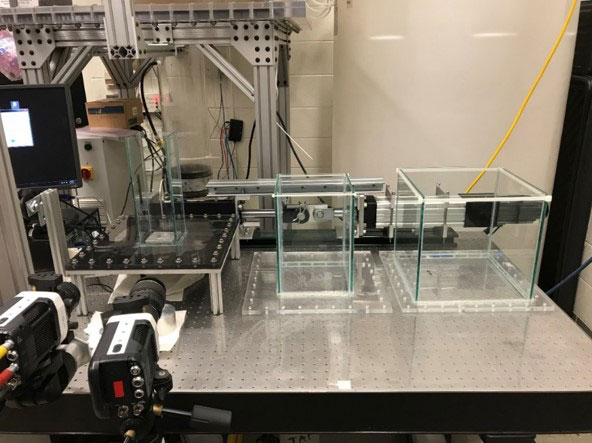Buoyant jets in stratified environments
Project Description
We are aiming at investigating the fluid-dynamics characteristics of buoyant jets and their interactions with stratified environments. Within this project we perform:
- High-resolution experiments using Particle Image Velocimetry (PIV) and Planar Laser Induced Fluorescence (PLIF)
- CFD models validation and further development (RANS and LES)
Experimental Facilities
Two experimental facilities are used for this project:
- DESTROJER facility (DEnsity Stratified Turbulent ROund free Jet ExpeRiment)
- miniDESTROJER
The DESTROJER setup consists of a 1m x 1m x 1m cubic tank, featuring a D=12.7mm jet nozzle diameter. The facility is made of acrylic glass to provide optical access for PIV and PLIF applications. The miniDESTROJET facility consists of a 30cm x 30cm x 30cm cubic tank instead, with a jet diameter of 2 mm.
Both facilities are equipped with a PIV system consisting of a Phantom Miro LAB 340 high-speed camera with 2,560×1,600 pixels, achieving 800Hz as the maximum frame rate at full resolution, and a double-cavity pulsed Nd:YLF Laser system having a maximum frequency of 10,000Hz at a wavelength of 527nm. A second Phantom Miro LAB 340 camera is used for simultaneous PLIF measurements
Velocity field for a Turbulent Jet at a Re = 5000
(see videos below)
Refractive Index Matching Technique
Optical techniques such as PIV and PLIF lose applicability when the mixing fluids have different refractive index, like in the case of a flow with density gradients. In this case, raw images appear blurred (see left video below) and seed particles appear smeared in the raw images leading to unreliable measurements for both velocity and concentration fields.
We have developed a novel Refractive-Index-Matching (RIM) technique that allows to systematically identify mixing fluids for which refractive index does not change with the mixing scalar. So far, we have been successfully tested the technique with density differences up to 9%.
video 1 below shows PIV measurements (raw data) for a buoyant jet. Bad quality images are due to non-uniform refractive index (density difference = 1.1%, Re = 5000)
video 2 shows PIV measurements (raw data) with Refractive Index Matching (RIM). High quality images are obtained (density difference = 7.9%, Re = 5000)
Measurements
Examples of measurements of buoyant jets in uniform and stratified environments are shown in the videos below.
video 1 shows light jet injected into heavier fluid (density difference = 7.9%, Re = 2100)
video 2 shows light jet into a two-layer stratified environment (density difference = 3.16%, Re = 4000)
video 3 shows light jet injected into heavier fluid (density difference = 7.9%, Re = 5000)
References
- S. Qin, B. Krohn, V. Petrov, A. Manera, “Velocity and Scalar Fields of a Turbulent Buoyant Jet in the Self-Similar Region”, Nuclear Technology, 1-15 (2019).
- B Krohn, S Qin, J Downing, V Petrov, A Manera, “An Experimental Study of Local Self-Similarity in the Mixing Transition of a Turbulent Free Jet”, Nuclear Science and Engineering 193 (1-2), pp. 171-184 (2019).
- S Qin, B Krohn, J Downing, V Petrov, A Manera, “High-Resolution Velocity Field Measurements of Turbulent Round Free Jets in Uniform Environments”, Nuclear Technology 205 (1-2), pp. 213-225 (2019).

